Are you looking into getting a new overdrive pedal, and have your eye on the classic tube screamer? It’s one of the best kinds of overdrive pedals out there, they sound great, and there’s plenty you can do with them.
In this article, I’ll go through the 4 best ways to use a tube screamer to get the most out of it. Plus I’ll run through some frequently asked questions at the end in case you need some more answers about tube screamers. So let’s get started!
The Quick Answer
A tube screamer pedal can be used to add crunch, overdrive or as a boost pedal. You can change the tone by adjusting the level (volume control), drive (level of saturation) and tone (warm or bright) for different effects. Tube screamers work best at the start or middle of the pedal chain.
Tube screamer pedals are a type of overdrive pedal. They are best known for creating a crunchy and saturated tone by adding gain, and increasing the mid-range and treble-frequencies and lowering the bass-frequencies.
The tube screamer’s ability to add grit and crunchy, allows you to use it in several different scenarios, to either add gain, volume, boost the mid-range frequencies, or all three. Tube screamers are commonly used to make your tone sound either crunchy, fuzzy and overdrive, or as boost pedals for soloing and lead guitar.
What is a Tube Screamer Pedal?
First, let’s start with exactly what a tube screamer pedal is.
Tube screamers are a type of overdrive pedal. There are a few main types of overdrive pedals including tube-screamer types, klon-types, amplifier emulators, pre-boosters and boosters. So it’s important to be clear from the start, that all tube screamers are overdrive pedals, but not all overdrive pedals are tube screamers.
So what kind of sound does a tube screamer produce?
Well, they’re best known for their gritty and crunchy tones. They produce an iconic kind of sound associated with many guitarists particularly from the blues, rock and indie scene.
It’s also important to note, that tube screamers are NOT distortion pedals. They sound less aggressive and are less suited to heavier genres like heavy metal. Instead of adding lots of gain, they aim to mimic the sound of driving a tube amp hard enough so that it distorts the signal, causing it to break up.
Ibanez Tube Screamer
The Ibanez Tube screamer is one of the most popular overdrive pedals out there. It’s what people often think of when they heard the words “tube screamer”, but it’s important to remember that they’re not the only brand that produce great tube screamers.
Ibanez Tube Screamers have been around since the 1970’s and have famously been used by guitarists like Stevie Ray Vaughan, Billie Joe Armstrong, Noel Gallagher and Alex Turner.
They’re best known for their ability to push mid-range frequencies. This is perfect for giving you a boost for solos.
There are three versions of the Tube Screamer:
– TS808
– TS9
– TS Mini
Check out my in-depth comparison between the different versions of the Ibanez Tube Screamer to learn more.
The Basic Controls
Now, let’s jump into the different controls that you’ll see on tube screamers, and how to use them.
They’re pretty straightforward to use, and don’t have too many different controls to worry about. On most tube screamers, you’ll be able to adjust the drive setting, level setting and tone setting.
- Level: this refers to the volume of the tube screamer. You can crank this up high if you want to turn it on and give you a boost for soloing etc., or you can turn down lower and use it constantly.
- Drive: this refers to how much of the overdrive effect is produced by the pedal. If you have the drive high, then the overdrive will be very intense and fuzzy. Alternatively, you can have it very low and it’ll just give your tone a hint of grit. If you have it midway, it’ll sound crunchier.
- Tone: this allows you to adjust how sharp, or mellow the tone sounds. It’s similar to the treble and bass controls on an amplifier. You can turn it left to make the tone more mellow and warm. Or turn it right so it sounds brighter and sharper.
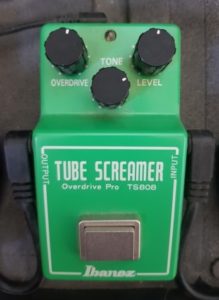
Through a Clean or Distorted Amp?
It’s also important to consider your amplifier settings when using a tube screamer pedal, and in particular the gain setting on your amp.
You’ll need to decide if you want to run your tube screamer pedal into a clean amp, distorted amp, or something in between.
The kind of effect you’ll get with each approach, is dicatated by two things, the amount of gain, and the EQ (treble, mids and bass balance).
So you already know that tube screamers add gain. So why would you have a distorted amp as well then? Well, you could do this for a few reasons. You may want to have a crunchier tone throughout a song, and then use your tube screamer as a boost to add even more gain.
Or you could want to do something known as “gain stacking”, to give you a more specific type of distortion. This relates the effect a tube screamer has on the EQ. Not only do tube screamers add gain, but they also reduce the bass frequencies and increase the mid-range and treble frequencies. This causes the tone to be more crunchy and gritty.
Running a tube screamer into a distorted amp allows you to increase the gain, but also sharpens the tone, making it less warm and mellow.
Alternatively, you could run your tube screamer into a completely clean amp. This is a good idea if you aren’t a huge fan of how your amp’s gain actually sounds, and you want to use a tube screamer purely to replace this function.
Pedal Chain Placement
Okay, so we’re nearly there. Before I jump into the different ways to use a tube screamer, I think it’s important to talk about pedal chain placement.
If you’re new to guitar effects pedals, then you may not know that the placement of the pedals is critical in impacting how they sound.
When you connect multiple pedals together, you need to do this in a chain, running from your guitar, to the amplifier. This causes the earlier pedals (closest to your guitar) to be affected by your later pedal (closest to the amp).
Most guitarists tend to put their tube screamers towards the start or middle of their pedal chain. This is because it’s common practise to put pedals that have the most significant effect on your tone, at the start of the chain, and those that have a lesser effect, towards the end.
It’s usually a good idea to put your tube screamer after any tuner, compression or wah-pedals. And put any modulation, pitch shifter, delay, reverb or volume pedals after your tube screamer.
The reason I don’t put distortion/ overdrive pedals after time-related effects or modulation effects, is because I don’t want to add gain to these effects, I want to add gain to the original guitar tone. For example, if you place your delay pedal before your distortion pedal, you’ll end up adding distortion to the delayed sounds.
This can end up sounding pretty messy and hard to tell what’s going on.
Looking to get the best out of your pedals? Check out my article on the best pedal chain order here to learn everything you need to know about setting up your chain.
4 Best Ways to Use a Tube Screamer
Okay, so now to the fun part, the different ways you can use your tube screamer to achieve different effects, for different situations.
Four of the best ways to use a tube screamer pedal are:
- For a crunchy tone
- For an overdriven fuzzy tone
- As a dirty boost pedal
- As a clean boost pedal
Now let’s go through exactly how you can achieve these kind of effects with your tube screamer. For each effect, i’ll go through the amp settings, pedal placement and controls you should be using.
1. For a Crunchy Tone
Firstly, we’ll talk about crunch tones. These are associated with plenty of different music styles including rock, indie and blues. You can get a light crunch tone, which just gives you a bit more bite and presence, or a heavier crunch tone, which is great for palm muting and punk rock.
Amp Settings
Let’s start with the amp settings. For a crunchy tone, it’s usually best to run the pedal through a relatively clean amplifier. You don’t want a lot of gain, so gain stacking with a tube screamer and a distorted amp isn’t really the best approach to take.
In terms of the treble, mids and bass settings on your amplifier, it’s hard to say what the exact settings should be, because it really depends what amp you’re using. However, generally, you’re looking for a saturated tone, so you’ll want to avoid using a lot of bass.
It’s usually best to have all the EQ controls at 12 o’clock, as this allows the tone of your tube screamer to shine through, and remain unaffected by your amplifier.
Pedal Chain Placement
You’re using the tube screamer for it’s original purpose if you’re looking to create a saturated and crunchy tone. Therefore, it’s best to have your tube screamer after any tuner or compression pedals, and before any other effects like modulation, delay or reverb.
Tube Screamer Controls
There are three controls you’ll need to consider, the drive, level and tone controls.
- Drive: you’ll want this on around 1/3 the way up (so around 10 o’clock). This creates grit and crunch, but doesn’t add much fuzz.
- Tone: you’ll want to adjust this so that it’s around 2/3 the way up (so around 2 o’clock). This will give you more treble, and reduce the bass, giving your tone a bit more bit.
- Level: usually you’ll want the level to be around midway. You’re not using it to increase the volume, so there shouldn’t be a huge jump in volume when you turn it on.
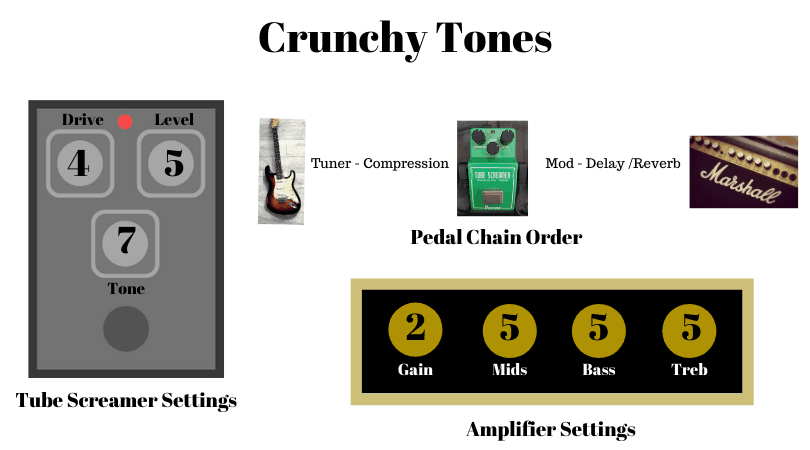
2. For an Overdriven Fuzzy Tone
Next, we’ll go through how to get a very overdriven, fuzzy tone. This is a very specific type of effect, and it goes beyond adding crunch and grit. This is more about adding a fizzy and noisy kind of tone. It won’t be as fuzzy as an actual fuzz pedal would be, but you can adjust your tube screamer settings so that it starts to sound this way.
Amplifier Settings
With a fuzzy overdriven tone in mind, you can start to think about gain stacking. This involves distorting your amp so that it contributes to this thicker overdriven tone. You don’t want to go overboard though. Aim to have your amp sound lightly saturated and crunchy, when the pedal is off.
So think about turning the gain up to around 3, if you have a solid state amp, or push your volume up a bit if you have a tube (or valve) amplifier.
In terms of your bass, mids and treble, you’ll want the tone to be a bit less harsh and trebly, than if you were going for a typical crunchy style sound. It depends on your amp, but if you’re struggling to get this fuzzier tone, then consider upping your bass setting slightly, and decreasing your treble.
It can be a good idea to set all your bass, mid and treble settings on your amp to halfway, this allows the tone of your tube screamer to control these frequencies. Taking this approach is usually a bit more straightforward and makes it easier to adjust your tube screamer itself and hear exactly what’s happening.
Pedal Chain Placement
Again, you are using the tube screamer primarily to add gain. So follow the same pedal chain order as you would if you were going for a crunchy tone. So have any tuner, wah or compression pedals on the guitar side, and any modulation effects e.g. tremolo, phaser, flanger etc., reverb, delay and volume, on the amplifier side of the pedal.
Tube Screamer Settings
If you’re going for a heavily overdriven and fuzzy tone, then you want to really push your tube screamer. Here’s what your level, drive and tone settings should look like.
- Drive: this should be cranked up to almost maximum. If it get’s too fuzzy and you’re getting a lot of feedback, then you may need to take it down a little bit.
- Tone: have this on around midway. It’ll give you a balanced sound. Having it too far to the left (less treble) will reduce the note separation and clarity, whilst having it too far to the right (more treble) will give you more feedback and harshness.
- Level: you don’t want the pedal to give you a huge increase in volume, unless you’re using it to give you a boost as well. Keep the level on around 5 to prevent a big increase in volume when you turn the pedal on.
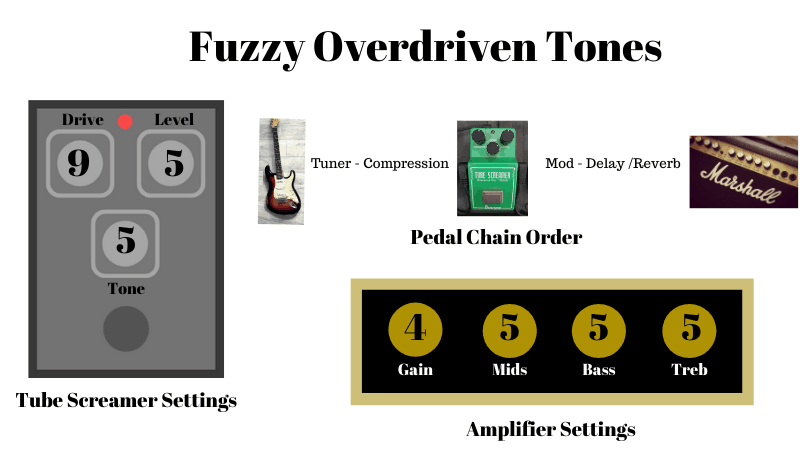
3. As a Dirty Boost
As well as using a tube screamer for the classic overdriven sound, you can also use it as a boost pedal for soloing and lead guitar sections. Tube screamers work great as dirty boost pedals, meaning that they’ll add both volume and gain.
This is a popular way to use a tube screamer. I often do this when switching from rhythm to lead sections for example, when playing a lot of Oasis songs. Take the song “Some Might Say” for example. i just want a crunchy rhythm tone for most of this song, but some sections require a lot more sustain and overdrive, so I use the tube screamer to do this.
Here’s exactly how you can use a tube screamer as a dirty boost pedal. If you want some more detail, then check out this article I’ve written on using a tube screamer pedal as a boost.
Amplifier Settings
Since you’re only using the tube screamer for certain specific sections of a song where you require more gain and volume, you need to set your amp as you would for the rest of a song.
Bear in mind that a tube screamer will add gain, but it works best if you don’t have a heavily distorted amp to start with. Overdrive pedals won’t give you an notifiable increase in gain, if you’re already running through a distorted amplifier. You’ll only get the increase in volume.
You should also consider your bass, mids and treble settings. Usually, you’ll be setting these up for rhythm guitar playing, if you’re using your tube screamer for lead sections. So you’ll want the mids to be fairly balanced (set around halfway), your bass to be on around 6, and your treble to be on around 4.
Of course, the exact settings you need will depend on your amp and guitar, so play about with them and see what works best for you.
Pedal Chain Placement
The pedal chain placement alters when you’re using a tube screamer for boosting, rather than just as a gain pedal.
This means that you should have your tube screamer after any other overdrive or distortion pedals. You should still have it before any reverb, delay or modulation effects in most cases.
Tube Screamer Settings
Since you’re using your tube screamer to give you a boost in terms of gain and volume, you’ll need to set the controls up differently. Here’s what your level, drive and tone controls should look like.
- Drive: you’ll want the drive setting to usually be on at least midway, sometimes higher. This will give you a noticeable increase in gain.
- Tone: since you’ll be using the tube screamer for lead guitar sections where you need to cut through the mix more, you’ll want your tone control to be set higher, usually on around 2/3 the way up. This will give more brightness and sharpness.
- Level: you’ll want the level on quite high to give you a noticeable increase in volume. Usually around 2/3 the way up will be enough, but you can adjust from here depending on how much of a boost you’re looking to get.
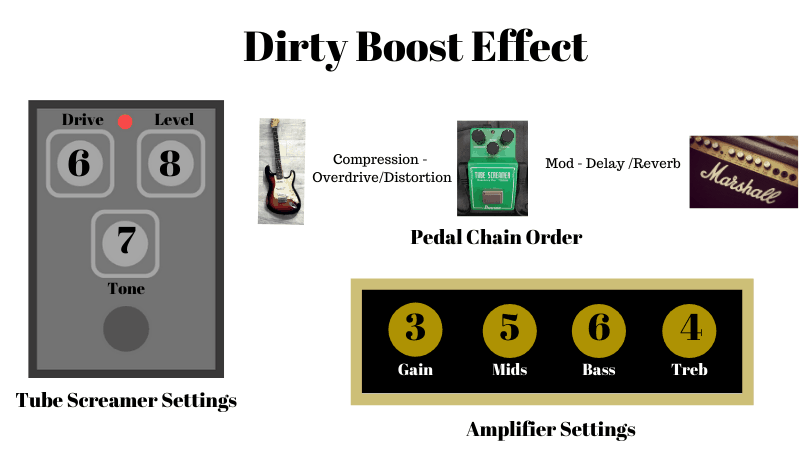
4. As a Clean Boost
The final way of using a tube screamer on this list, is for a clean boost. This is for when you only want an increase in volume, rather than an increase in the level of gain as well. It’s useful to do this if you’re happy with your tone, but just need to kick the volume up a notch for soloing or lead guitar sections.
It’s worth keeping in mind, that tube screamers are not necessarily designed to work as clean boosters. You won’t be able to get an entirely clean boost, however, you can set up your tube screamer so that you get an increase in volume, and very little increase in gain, if you run it into a distorted amplifier.
Here’s how to setup your tube screamer for clean boosting.
Amplifier Settings
Tube screamers work best as clean boosters, when you’re already using an overdriven amplifier, or another gain pedal. Hence, you’ll usually want a bit of distortion on your amplifier. The exact amount depends on what you want the rhythm sections to sound like, when you’re not turning the tube screamer on.
In terms of the bass mids and treble, again you should set it up for how you want your tone to be when you aren’t using the tube screamer. Usually you’ll be using it for rhythm playing, so you’ll want slightly boosted bass settings, and you’ll want to back off on the treble a bit. The mids will usually sound best when it’s pretty balanced (on halfway).
Pedal Chain Placement
Since you’re only really using the tube screamer for a volume increase in this scenario, you’ll want to adjust the pedal chain accordingly.
So, have all your compression, distortion, overdrive, wah and fuzz pedals before your tube screamer (closest to the guitar).
There is some debate as to where you should put reverb, delay and modulation pedals when using a tube screamer as a clean boost.
Generally, I think it sounds best when you put it after your modulation effect pedals, and before your delay and reverb. This allows it to act as a volume booster, but without interfering with the time-based effects like reverb and delay.
Tube Screamer Settings
If you’re using your tube screamer as a clean booster, then you’ll need to set up the controls quite differently to how you would do in the previous three approaches we’ve talked about.
- Drive: you’ll want this on very low, so on around 1-2, in order to get the cleanest boost possible.
- Tone: you’ll usually need to increase this to around 2/3 the way up. This gives you enough treble to cut through the mix.
- Level: you’ll want this on maximum to give you enough of a volume boost.
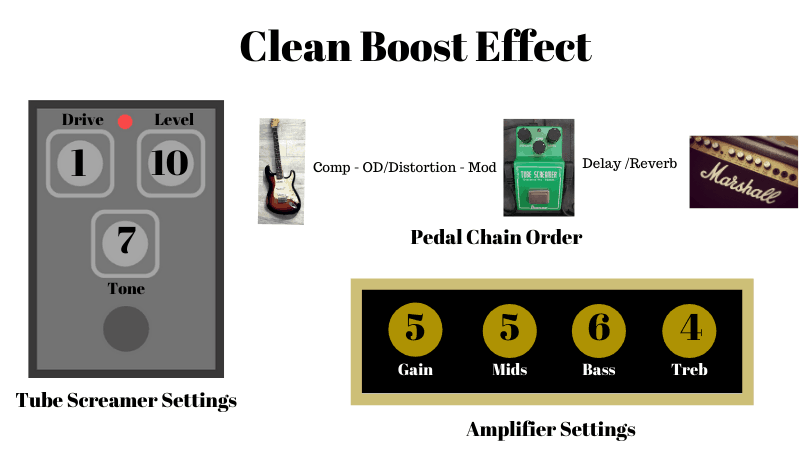
FAQs
Don’t worry if you’ve still got some questions about using your tube screamer, here are some answers to the most commonly asked questions.
can you use a tube screamer for metal?
Usually, tube screamers aren’t used for metal and other heavier genres of music. Although they add gain, they are overdrive pedals, not distortion pedals. Hence, for metal you’ll typically need something a bit more aggressive.
is a tube screamer an overdrive or distortion pedal?
Tube screamers are overdrive pedals, not distortion pedals. Overdrive pedals sound more gritty and crunchy, whereas distortion pedals are more aggressive and offer more gain and sustain. Take a look at this post I’ve written talking about why the tube screamer isn’t a distortion pedal.
can you use a tube screamer with another gain pedal?
You can use tube screamers with other gain pedals, this is known as gain stacking. It involves using several gain pedals in combination with each other. You do need to think carefully about pedal chain placement when doing this to make the most out of each pedal type. Take a look at this post on pedal chain ordering for gain pedals to learn more about this topic.
So there you go! Those are the best ways to use a tube screamer pedal! I hope you’ve found this article helpful, thanks for reading. Here are some other posts you might find useful:
